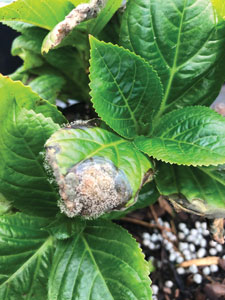2/1/2022
Going Gray?
Paul Pilon

By the time you read this, we’re approaching and possibly amidst what I like to call Botrytis season. Don’t get me wrong—Botrytis can attack crops throughout the year, but from my experience, Botrytis is most prevalent from the late winter through early to mid-spring.
During this time of year, I frequently see Botrytis in the late stages of propagation, during production and on plants coming out of the overwintering period. You’d think Botrytis on plants in the cold or coming out of dormancy wouldn’t be too problematic, but I can tell you from personal experience that Botrytis can unexpectedly wreak havoc on certain crops such as echinacea and heuchera. Be prepared and don’t get caught off guard this Botrytis season.
Botrytis AKA Gray mold
In case you don’t already know, Botrytis is a fungal pathogen (namely Botrytis cineria) that attacks a wide range of plants. It can be observed on any above-ground parts of the plant, but tends to develop on damaged or dead plant parts, such as dead leaves on the media surface or senescing flower parts. There are many diseases that plants get, but I’d dare say Botrytis occurs the most frequently.
Like its common name gray mold implies, Botrytis is most commonly identified by the fuzzy gray or brown spore masses on infected plant parts. Before the fuzzy spores develop, infected parts of the plant often appear as brown, water-soaked areas. Botrytis requires damaged or dead plant parts for infections to occur. However, once Botrytis gets going, it quickly spreads to healthy parts of the plants.
Besides damaged or dead plant parts, there are other requirements for Botrytis infections to occur. The primary factor is extended periods of free moisture on plant parts; infections can begin when at least four hours of free moisture occurs. Leaf wetness combined with high humidity levels are ideal conditions for this disease. Dew on the leaves and/or dripping condensation from structures are commonly associated with Botrytis infections.
 Like many diseases, Botrytis can occur under a wide range of temperatures (55 to 84F/13 to 29C) with 64 to 70 (18 to 21C) being optimal. Surprisingly, Botrytis can actively infect plants with temperatures as low as 34F (1C); however, it usually doesn’t become too problematic until the temperatures reach at least 50F (10C). Growers can be caught off guard by these mid- to late-winter infections; be on the lookout when unseasonably warm conditions occur during the late winter.
Like many diseases, Botrytis can occur under a wide range of temperatures (55 to 84F/13 to 29C) with 64 to 70 (18 to 21C) being optimal. Surprisingly, Botrytis can actively infect plants with temperatures as low as 34F (1C); however, it usually doesn’t become too problematic until the temperatures reach at least 50F (10C). Growers can be caught off guard by these mid- to late-winter infections; be on the lookout when unseasonably warm conditions occur during the late winter.
Pictured: Botrytis develops on damaged or dead plant tissues, such as on this hydrangea.
Spores are released naturally in the mid-morning to mid-afternoon with the rapid decrease in relative humidity that occurs each day. They spread throughout the crops with air movement, splashing water and many production activities, such as watering, spraying, spacing, pinching, etc.
First line of defense
Managing the environmental conditions is the first line of defense and the most effective strategy for preventing Botrytis outbreaks. When possible, follow these guidelines:
• Avoid having wet foliage
— Avoid overhead irrigation in the late afternoon or during cloudy conditions
— Sparingly water while overwintering plants—surface moisture can be problematic
• Reduce the humidity to below 75% (below 70% RH is even better)
• Use ventilation and humidity purges around the clock 24/7
• Use horizontal airflow fans to increase air movement at plant level and within the canopy
• Provide wise spacings between plants for the most susceptible crops
• Reduce or eliminate condensation by avoiding wide temperature fluctuations and using greenhouse coverings treated with anti-condensate
The big guns
Even with using some of the environmental strategies listed above, it’s often necessary or beneficial to apply fungicides or biofungicides to keep Botrytis at bay. Here’s a listing of several fungicides I find to be highly effective against Botrytis:
• Astun (FRAC mode of action group 7)
— Don’t rotate with fungicides containing groups 7 and 11
• BotryStop (bio-fungicide)
• Chipco 26019 (FRAC mode of action group 2)
• Palladium (FRAC mode of action groups 9 and 12)
• Decree (FRAC mode of action group 17)
• Broadform, Mural and Pageant (FRAC mode of action groups 7 and 11)
(There are other options available for controlling Botrytis; however, the products above are my go-to fungicides when chemical controls are needed.)
Going gray is a fact of life as we get older, but when it comes to plants, gray isn’t a welcomed sight. I hope you’re able to use this information to have a relatively Botrytis-free season. GT
Paul Pilon is editor-at-large of the Perennial Pulse e-newsletter and Director of Growing at Opel Growers in Hudsonville, Michigan. He can be reached at paul@opelgrowers.com.